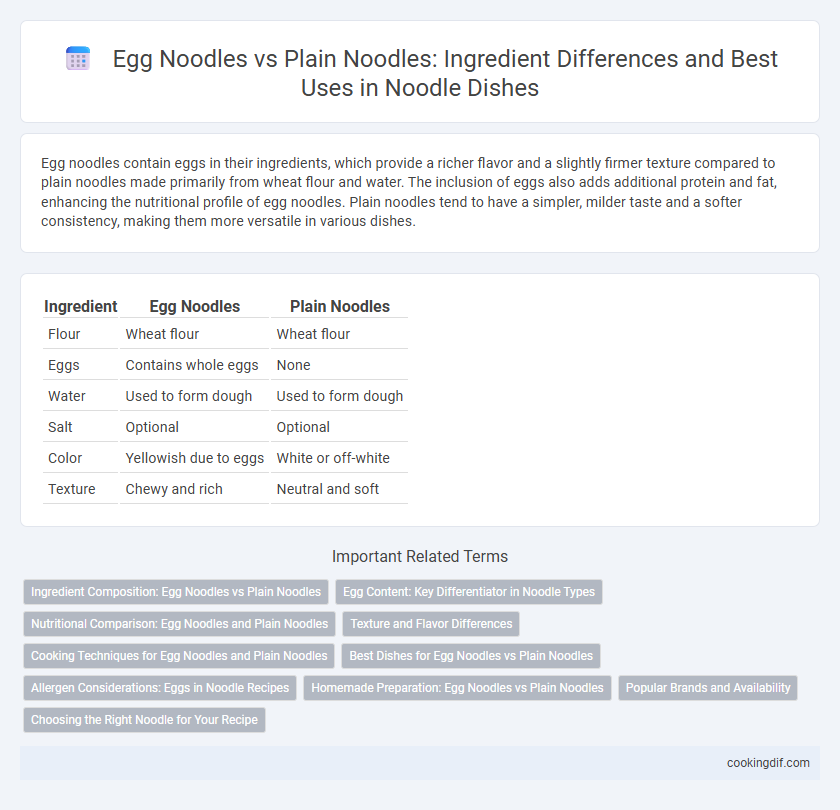Egg noodles contain eggs in their ingredients, which provide a richer flavor and a slightly firmer texture compared to plain noodles made primarily from wheat flour and water. The inclusion of eggs also adds additional protein and fat, enhancing the nutritional profile of egg noodles. Plain noodles tend to have a simpler, milder taste and a softer consistency, making them more versatile in various dishes.
Table of Comparison
| Ingredient | Egg Noodles | Plain Noodles |
|---|---|---|
| Flour | Wheat flour | Wheat flour |
| Eggs | Contains whole eggs | None |
| Water | Used to form dough | Used to form dough |
| Salt | Optional | Optional |
| Color | Yellowish due to eggs | White or off-white |
| Texture | Chewy and rich | Neutral and soft |
Ingredient Composition: Egg Noodles vs Plain Noodles
Egg noodles contain wheat flour, water, and a significant amount of eggs, which enrich their protein and fat content, giving them a richer flavor and firmer texture. Plain noodles, primarily made from wheat flour and water, have a simpler composition, resulting in a lighter taste and a softer bite. The presence of eggs in egg noodles also contributes to a higher nutritional value, including additional vitamins and minerals.
Egg Content: Key Differentiator in Noodle Types
Egg noodles contain a higher protein content due to the inclusion of whole eggs, which enriches their flavor and texture compared to plain noodles made solely from wheat flour and water. The presence of egg yolks adds natural fats and a golden color, enhancing the noodle's taste profile and nutritional value. This key ingredient difference impacts cooking properties, making egg noodles firmer and more resilient in soups and stir-fries.
Nutritional Comparison: Egg Noodles and Plain Noodles
Egg noodles contain higher protein and fat levels due to the inclusion of eggs, providing approximately 7 grams of protein and 3 grams of fat per 100 grams. Plain noodles, typically made from wheat flour and water, have lower protein content, around 5 grams per 100 grams, and minimal fat. Both types offer similar carbohydrate amounts, roughly 70 grams per 100 grams, but egg noodles deliver extra vitamins like Vitamin A and B12 from eggs.
Texture and Flavor Differences
Egg noodles contain eggs which create a richer flavor and a firmer, chewier texture compared to plain noodles made solely from flour and water, resulting in a softer and more neutral base. The added protein and fat from eggs in egg noodles contribute to a slightly yellow hue and a more complex taste profile. Plain noodles offer a versatile canvas for sauces and spices, while egg noodles enhance hearty dishes with their fuller mouthfeel and savory undertones.
Cooking Techniques for Egg Noodles and Plain Noodles
Egg noodles, enriched with eggs, require gentler cooking techniques to maintain their tender texture, often involving boiling in plenty of water for a shorter time to prevent overcooking and breakage. Plain noodles, typically made from just flour and water, demand slightly longer boiling times and can withstand more vigorous stirring to avoid clumping. Both types benefit from rinsing under cold water after cooking to halt the cooking process and preserve their ideal consistency for various dishes.
Best Dishes for Egg Noodles vs Plain Noodles
Egg noodles, made with wheat flour and eggs, offer a richer texture and flavor ideal for creamy dishes like stroganoff and chicken noodle soup, enhancing their savory depth. Plain noodles, typically made from just flour and water, provide a neutral base perfect for light broths, stir-fries, and pasta salads where the sauce or seasoning is the main focus. Choosing between egg noodles and plain noodles depends on the dish's desired texture and flavor intensity, with egg noodles excelling in hearty recipes and plain noodles shining in delicate or highly seasoned preparations.
Allergen Considerations: Eggs in Noodle Recipes
Egg noodles contain eggs as a primary ingredient, which is a significant allergen for many individuals, whereas plain noodles typically exclude eggs, reducing allergenic risks. For those with egg allergies or sensitivities, plain noodles offer a safer alternative without compromising texture or taste in many recipes. Careful label reading and recipe adjustments are essential to accommodate dietary restrictions and avoid cross-contamination in noodle preparation.
Homemade Preparation: Egg Noodles vs Plain Noodles
Homemade egg noodles incorporate eggs into the dough, resulting in a richer flavor and a slightly denser texture compared to plain noodles, which rely solely on flour and water. Egg noodles tend to be more pliable and hold sauces better, making them ideal for hearty dishes and soups. Plain noodles offer a lighter texture and are versatile for a variety of recipes, especially where a subtle base is preferred.
Popular Brands and Availability
Egg noodles commonly contain wheat flour, eggs, and water, offering a richer flavor and firmer texture compared to plain noodles, which primarily rely on wheat flour and water. Popular brands such as Barilla and Annie Chun's feature both varieties, with egg noodles often found under specialty or refrigerated sections, while plain noodles like ramen or spaghetti are widely available in dried form across most grocery stores. Availability varies by region, but plain noodles typically dominate global supermarket shelves, whereas egg noodles are favored in Asian and European cuisines with targeted distribution.
Choosing the Right Noodle for Your Recipe
Egg noodles contain eggs, which add richness and a slightly chewy texture, making them ideal for creamy sauces and hearty dishes. Plain noodles are typically made from wheat and water, offering a neutral taste that absorbs flavors well, suitable for broths and stir-fries. Selecting between egg and plain noodles depends on the recipe's flavor profile and desired texture, with egg noodles enhancing richness and plain noodles providing versatility.
Egg noodles vs plain noodles for ingredients Infographic

 cookingdif.com
cookingdif.com